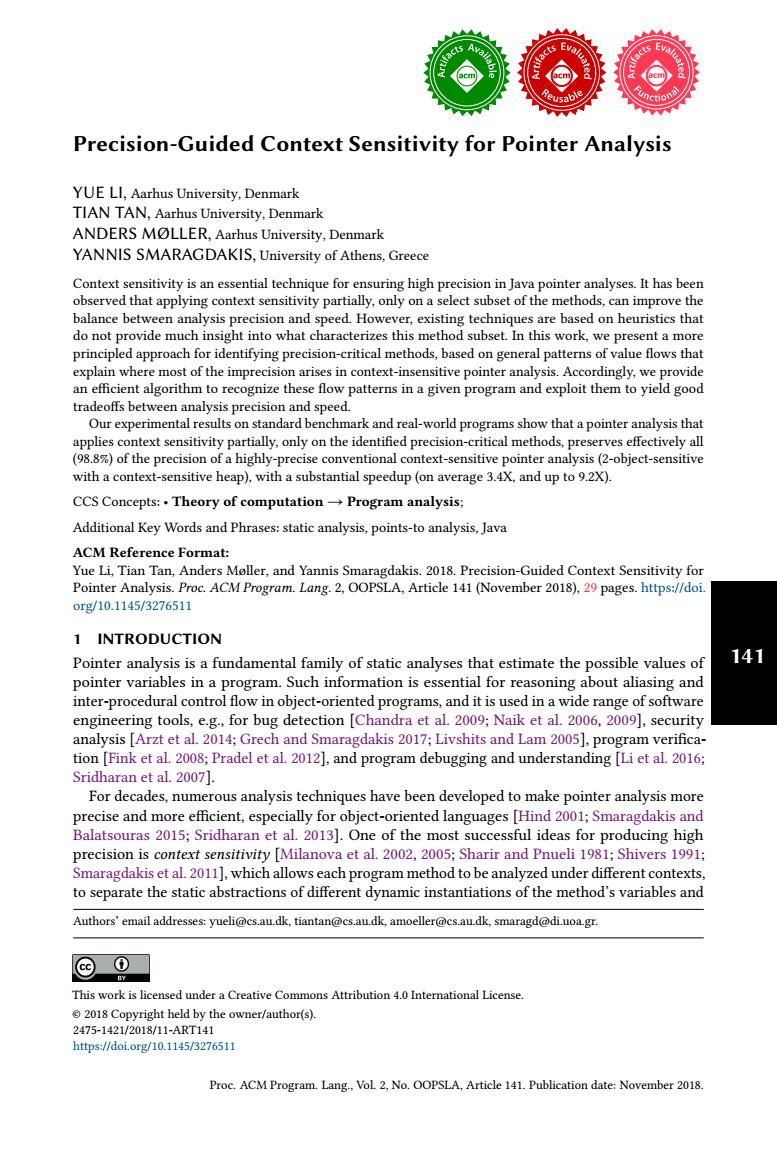正在加载图片...

cm acm sable Precision-Guided Context Sensitivity for Pointer Analysis YUE LI,Aarhus University,Denmark TIAN TAN,Aarhus University,Denmark ANDERS MOLLER,Aarhus University,Denmark YANNIS SMARAGDAKIS,University of Athens,Greece Context sensitivity is an essential technique for ensuring high precision in Java pointer analyses.It has been observed that applying context sensitivity partially,only on a select subset of the methods,can improve the balance between analysis precision and speed.However,existing techniques are based on heuristics that do not provide much insight into what characterizes this method subset.In this work,we present a more principled approach for identifying precision-critical methods,based on general patterns of value flows that explain where most of the imprecision arises in context-insensitive pointer analysis.Accordingly,we provide an efficient algorithm to recognize these flow patterns in a given program and exploit them to yield good tradeoffs between analysis precision and speed. Our experimental results on standard benchmark and real-world programs show that a pointer analysis that applies context sensitivity partially,only on the identified precision-critical methods,preserves effectively all (98.8%)of the precision of a highly-precise conventional context-sensitive pointer analysis(2-object-sensitive with a context-sensitive heap),with a substantial speedup (on average 3.4X,and up to 9.2X). CCS Concepts:.Theory of computation-Program analysis; Additional Key Words and Phrases:static analysis,points-to analysis,Java ACM Reference Format: Yue Li,Tian Tan,Anders Moller,and Yannis Smaragdakis.2018.Precision-Guided Context Sensitivity for Pointer Analysis.Proc.ACM Program.Lang.2,OOPSLA,Article 141(November 2018),29 pages.https://doi. org/10.1145/3276511 1 INTRODUCTION Pointer analysis is a fundamental family of static analyses that estimate the possible values of 14 pointer variables in a program.Such information is essential for reasoning about aliasing and inter-procedural control flow in object-oriented programs,and it is used in a wide range of software engineering tools,e.g.,for bug detection [Chandra et al.2009;Naik et al.2006,2009],security analysis [Arzt et al.2014;Grech and Smaragdakis 2017;Livshits and Lam 2005].program verifica- tion [Fink et al.2008;Pradel et al.2012],and program debugging and understanding [Li et al.2016; Sridharan et al.2007]. For decades,numerous analysis techniques have been developed to make pointer analysis more precise and more efficient,especially for object-oriented languages [Hind 2001;Smaragdakis and Balatsouras 2015;Sridharan et al.2013].One of the most successful ideas for producing high precision is context sensitivity [Milanova et al.2002,2005;Sharir and Pnueli 1981;Shivers 1991; Smaragdakis et al.2011],which allows each program method to be analyzed under different contexts, to separate the static abstractions of different dynamic instantiations of the method's variables and Authors'email addresses:yueli@cs.au.dk,tiantan@cs.au.dk,amoeller@cs.au dk,smaragd@diuoagr. This work is licensed under a Creative Commons Attribution 4.0 International License. 2018 Copyright held by the owner/author(s). 2475-1421/2018/11-ART141 https:/doi.org10.1145/3276511 Proc.ACM Program.Lang.,Vol.2,No.OOPSLA,Article 141.Publication date:November 2018.141 Precision-Guided Context Sensitivity for Pointer Analysis YUE LI, Aarhus University, Denmark TIAN TAN, Aarhus University, Denmark ANDERS MéLLER, Aarhus University, Denmark YANNIS SMARAGDAKIS, University of Athens, Greece Context sensitivity is an essential technique for ensuring high precision in Java pointer analyses. It has been observed that applying context sensitivity partially, only on a select subset of the methods, can improve the balance between analysis precision and speed. However, existing techniques are based on heuristics that do not provide much insight into what characterizes this method subset. In this work, we present a more principled approach for identifying precision-critical methods, based on general patterns of value flows that explain where most of the imprecision arises in context-insensitive pointer analysis. Accordingly, we provide an efficient algorithm to recognize these flow patterns in a given program and exploit them to yield good tradeoffs between analysis precision and speed. Our experimental results on standard benchmark and real-world programs show that a pointer analysis that applies context sensitivity partially, only on the identified precision-critical methods, preserves effectively all (98.8%) of the precision of a highly-precise conventional context-sensitive pointer analysis (2-object-sensitive with a context-sensitive heap), with a substantial speedup (on average 3.4X, and up to 9.2X). CCS Concepts: • Theory of computation → Program analysis; Additional Key Words and Phrases: static analysis, points-to analysis, Java ACM Reference Format: Yue Li, Tian Tan, Anders Mùller, and Yannis Smaragdakis. 2018. Precision-Guided Context Sensitivity for Pointer Analysis. Proc. ACM Program. Lang. 2, OOPSLA, Article 141 (November 2018), 29 pages. https://doi. org/10.1145/3276511 1 INTRODUCTION Pointer analysis is a fundamental family of static analyses that estimate the possible values of pointer variables in a program. Such information is essential for reasoning about aliasing and inter-procedural control flow in object-oriented programs, and it is used in a wide range of software engineering tools, e.g., for bug detection [Chandra et al. 2009; Naik et al. 2006, 2009], security analysis [Arzt et al. 2014; Grech and Smaragdakis 2017; Livshits and Lam 2005], program verification [Fink et al. 2008; Pradel et al. 2012], and program debugging and understanding [Li et al. 2016; Sridharan et al. 2007]. For decades, numerous analysis techniques have been developed to make pointer analysis more precise and more efficient, especially for object-oriented languages [Hind 2001; Smaragdakis and Balatsouras 2015; Sridharan et al. 2013]. One of the most successful ideas for producing high precision is context sensitivity [Milanova et al. 2002, 2005; Sharir and Pnueli 1981; Shivers 1991; Smaragdakis et al. 2011], which allows each program method to be analyzed under different contexts, to separate the static abstractions of different dynamic instantiations of the method’s variables and Authors’ email addresses: yueli@cs.au.dk, tiantan@cs.au.dk, amoeller@cs.au.dk, smaragd@di.uoa.gr. Permission to make digital or hard copies of part or all of this work for personal or classroom use is granted without fee provided that copies are not made or distributed for profit or commercial advantage and that copies bear this notice and the full citation on the first page. Copyrights for third-party components of this work must be honored. For all other uses, contact the owner/author(s). © 2018 Copyright held by the owner/author(s). 2475-1421/2018/11-ART141 https://doi.org/10.1145/3276511 Proc. ACM Program. Lang., Vol. 2, No. OOPSLA, Article 141. Publication date: November 2018. This work is licensed under a Creative Commons Attribution 4.0 International License